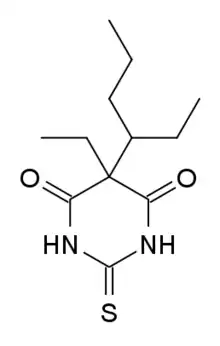Thiotetrabarbital
 | |
| Clinical data | |
|---|---|
| Other names | JL-1014 |
| ATC code |
|
| Identifiers | |
IUPAC name
| |
| CAS Number | |
| PubChem CID | |
| ChemSpider | |
| UNII | |
| Chemical and physical data | |
| Formula | C12H20N2O2S |
| Molar mass | 256.36 g·mol−1 |
| 3D model (JSmol) | |
SMILES
| |
InChI
| |
Thiotetrabarbital (INN; Thionarcex) is a drug which is a short-acting barbiturate derivative that is used as an anesthetic.[1][2][3][4][5] It has been used in veterinary medicine.[6]
See also
References
- ↑ Macdonald F (1997). Dictionary of Pharmacological Agents. CRC Press. p. 1964. ISBN 978-0-412-46630-4. Retrieved 22 April 2012.
- ↑ Westhorpe RN, Ball C (December 2002). "The intravenous barbiturates". International Congress Series. 1242: 57–69. doi:10.1016/S0531-5131(02)00758-6.
- ↑ "Newer barbiturates". British Journal of Anaesthesia. 27 (8): 418–419. 1955. doi:10.1093/bja/27.8.418.
- ↑ Hewer CL (1963). Recent advances in anæsthesia and analgesia. Little, Brown. p. 31. Retrieved 27 April 2012.
- ↑ Dundee JW, Wyant GM (1974). Intravenous anaesthesia. Churchill Livingstone. ISBN 978-0-443-00977-8. Retrieved 27 April 2012.
- ↑ Nordisk veterinaermedicin. 1962. p. 341. Retrieved 27 April 2012.
This article is issued from Offline. The text is licensed under Creative Commons - Attribution - Sharealike. Additional terms may apply for the media files.